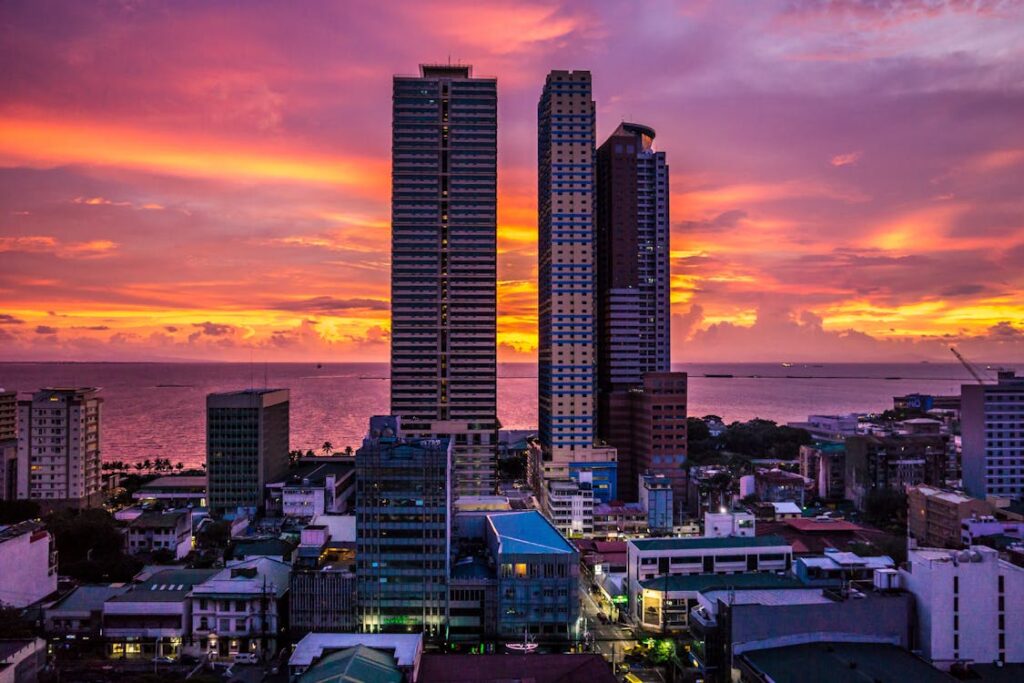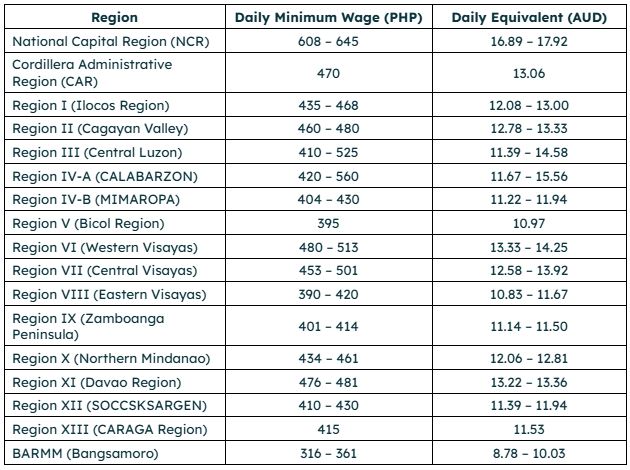While the idea of cost-effective labour gets a lot of airtime, the actual average salary in the Philippines is often misunderstood, oversimplified, or just outdated. And outdated data leads to bad business decisions.
The truth is, Philippine salary structures are layered. They’re shaped by region, role, industry, and even the kind of company you’re running. A junior developer in Manila doesn’t earn the same as a customer service agent in Davao. Nor should they.
But if you’re hiring offshore teams, you need more than gut feeling or hearsay. You need benchmarks. You need to know what competitive looks like andwhat exploitative looks like, too.
This guide does exactly that. We break down the numbers, the context, and the nuance behind the average salaries in the Philippines in 2026.
Whether you’re an Australian business exploring outsourcing or a startup founder building your first offshore team, consider this your roadmap to paying fairly, competitively, and strategically.
Quick Navigation: 2025 Philippines Salaries GuideTable of Contents
- What is the Average Salary in the Philippines?
- Minimum Wage in the Philippines
- Key Factors Influencing the Average Salary in the Philippines
- Average Salary in the Philippines by Industry and Role (2026 Projections)
- Leveraging the Cost of Philippine Salaries by Outsourcing
- Best Practices for Navigating Compensation in the Philippines
- Attract Skilled Workers with Competitive Salaries in the Philippines
- FAQs
What is the Average Salary in the Philippines?
The national average monthly salary in the Philippines sits at around PHP 18,423(AUD 511), based on data aggregated by the Philippine Statistics Authority (PSA) back in 2022.
Of course, that number today is a generalisation. Philstar reported that the average salary of Filipino workers is projected to increase by 5.5%in 2025.

Metro Manila (where the country’s capital is) typically reports much higher averages: Closer to PHP 27,000(AUD 750) as per Glassdoor. Entry-level roles in provincial areas, on the other hand, can be much lower. It’s important to use this number as a baseline, not a rule.
Minimum Wage in the Philippines
The Philippines doesn’t have one national minimum wage rate. Instead, rates change from region to region. This setup reflects the different economic conditions and living costs in each area across the country.
The National Wages and Productivity Commission (NWPC) and the Regional Tripartite Wages and Productivity Boards (RTWPBs) determine local minimum wages. Updates happen at different times in each region and are set daily. This makes tracking the minimum wage across the Philippines tricky without expert help.
Here’s a snapshot of daily minimum wages for non-agriculture private sector workers. We’ve also included the Australian dollar equivalent (rounded to the nearest AUD based on a PHP 36 = AUD 1 exchange rate as of June 2025):

These are the baseline rates, but actual wages vary based on role and experience. Note that most outsourced or white-collar roles pay well above these figures.
Key Factors Influencing the Average Salary in the Philippines
Several elements shape the average salary in the Philippines for any given role. Businesses must understand these dynamics to craft competitive and effective compensation packages:

Industry and Job Role
Some careers just pay more because certain skills are harder to find or more valuable. That’s why someone in IT or developmentmight earn twice as much as someone in customer support, even if both work equally hard.
It’s not always fair, but it’s how supply and demand shape the job market. A developer writing code for a fintech startup will likely out-earn a call centre agent, simply because their skill set is harder to replace.
Experience Level
Experience is a salary multiplier.
Entry-level hires come with lower costs but need more oversight. Mid-career professionals bring efficiency and stability, while senior hires often drive strategy and expect compensation that reflects that.
If your salary bands don’t account for these differences, you risk losing workers at the exact moment they become most valuable to your business.
Location
Hiring across different regions in the Philippines? Salary expectations shift dramatically depending on where candidates live.
Metro Manila commands higher rates, especially in hubs like Makati and Taguig (BGC), where the cost of living and competition are steep.
But hiring from Iloilo, Davao, or Cebu? You could access the same skills at around 15-75% less, according to computed data from Respicio & Co.
Skills and Certifications
Candidates with in-demand skills (like Python, cloud computing, or CPA licenses) command premium rates. That’s because they show initiative, credibility, and up-to-date expertise. If your roles require specialised skills, expect to pay above baseline.
Company Type
Your company’s size and structure play a big role in what candidates expect and what they’ll accept. Multi-national corporations (MNCs) and large enterprises usually win on salary and benefits, but that doesn’t mean smaller businesses can’t compete.
If you’re a startup, lean into your strengths: autonomy, growth, and culture. Just be transparent. Today’s job market rewards honesty as much as it does compensation.
Average Salary in the Philippines by Industry and Role (2026 Projections)
These are projectedaverage monthly salaries for common roles using compiled data from trusted sources like Talent.com and Payscale. All figures are in Philippine Pesos (PHP), with their Australian dollar (AUD) equivalents.

Note that these figures can fluctuate, possibly significantly, at any time.
Information Technology (IT)
- Web Developer: PHP 55,000 – 75,000 (AUD 1,526 – 2,081)
- Software Engineer: PHP 35,000 – 48,000 (AUD 971 – 1,332)
- IT Manager: PHP 90,000 – 120,000 (AUD 2,368 – 3,158)
BPO / Customer Service
- Customer Service Rep: PHP 18,000 – 28,000 (AUD 475 – 737)
- Team Leader: PHP 35,000 – 50,000 (AUD 921 – 1,315)
- Operations Manager: PHP 70,000 – 95,000 (AUD 1,842 – 2,500)
Healthcare & Medical
- Registered Nurse (Private Sector): PHP 25,000 – 35,000 (AUD 658 – 921)
- Medical Coder: PHP 30,000 – 45,000 (AUD 789 – 1,185)
- Telehealth Doctor: PHP 80,000 – 120,000 (AUD 2,105 – 3,158)
Finance & Accounting
- Junior Accountant: PHP 22,000 – 30,000 (AUD 578 – 789)
- CPA/Financial Analyst: PHP 40,000 – 60,000 (AUD 1,052 – 1,578)
- Finance Manager: PHP 80,000 – 110,000 (AUD 2,105 – 2,894)
Digital Marketing & Creative
- Graphic Designer: PHP 27,000 – 60,000 (AUD 749 – 1,665)
- Content Writer: PHP 25,000 – 50,000 (AUD 693 – 1,387)
- SEO Specialist: PHP 36,000 – 50,000 (AUD 999 – 1,526)
Leveraging the Cost of Philippine Salaries by Outsourcing
If you’re running a business outside the Philippines, say in Sydney, New York, or London, it’s easy to underestimate how far your budget can stretch here.
But once you dig into average salaries, the numbers speak for themselves: labour costs in the Philippines are often 70% lowerthan what you’d pay back home. And no, this isn’t about cutting corners or hiring the cheapest help available.
Businesses that have had the pleasure of expanding their teams in the Philippines know that they’re working with smart, capable people who speak excellent English. Filipino workers are known to adapt quickly and genuinely care about doing good work.
Outsourcing to this Southeast Asian country is a way to unlock expertisethat punches above its weight. The savings are real, but the real win? You get to reinvest that money into things that fuel growth, like new products, better tools, or hiring even more great people.
Best Practices for Navigating Compensation in the Philippines
As an employer looking to hire in the Philippines, understanding the salary system is only the first step. Effective compensation strategies require careful planning and execution:

- Pay above minimum wage.You’re not just meeting legal requirements, you’re signalling respect.
- Conduct proper salary benchmarking.Use multiple reputable salary guides, industry reports, and local recruitment agencies to gather comprehensive data. This guarantees that your offers align with current market rates for specific roles and locations.
- Offer non-monetary benefits.Employees in the Philippines value benefits such as health insurance, paid leave, holiday bonuses (like the 13th-month pay, which is legally mandated), and opportunities for professional development.
- Monitor economic trends and inflation.The Philippine economy, like any other, experiences inflation and shifts in cost of living. Stay updated on these trends to make necessary salary adjustments and maintain the purchasing power of your employees’ wages.
- Be transparent.Philippine professionals value clarity in pay structure, bonuses, and appraisal systems.
Attract Skilled Workers with Competitive Salaries in the Philippines

If you’re fully in with hiring people in the Philippines, now you know you’re getting more than just a good deal. By understanding what the average salaries are, you’ll better know the market well enough to pay people what they’re worth, and still come out ahead.
Understand the going rates. Match them where it counts. Go above them where it matters. If you want loyalty, efficiency, and long-term gains, compensation planning should be part of your strategy.
FAQs
What is the typical salary for remote Filipino workers in 2026?
It depends on the role, but most remote white-collar professionals earn between PHP 25,000 and PHP 60,000 monthly (AUD 658 – 1,578).
What is the 13th-month pay in the Philippines?
The 13th-month pay is a mandatory, government-mandated benefit for all private sector employees in the Philippines who have worked for at least one month. Employers must pay it by December 24th each year, equivalent to one-twelfth (1/12) of an employee’s basic salary earned during the year.
Are salary rates different between local and international employers?
They can be. Foreign employers, especially from Australia and the US, often offer higher-than-local-market rates to attract top professionals.